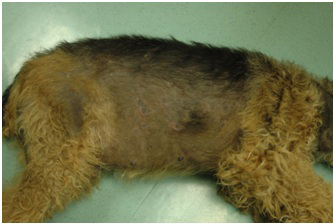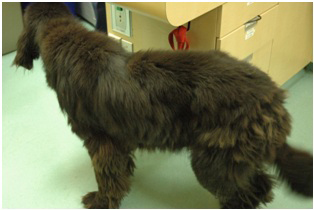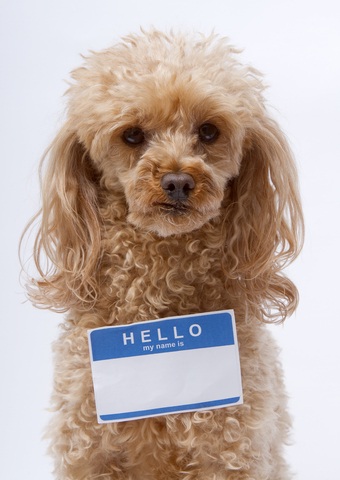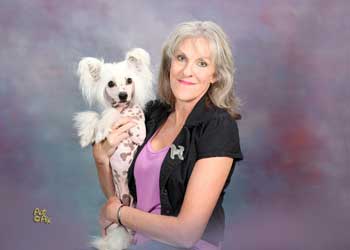Derm disease: Hypothyroidism
 (Image left: Hypothyroidism can cause hair loss and sores as shown in this patient. Photo: Animal Dermatology Clinic
(Image left: Hypothyroidism can cause hair loss and sores as shown in this patient. Photo: Animal Dermatology Clinic)
Hypo- means deficient or inactive, so hypothyroidism is deficient thyroid hormone. Whoa! Isn’t the thyroid on the inside of the dog? Why would the doctors at Animal Dermatology Clinic deal with an internal disorder?
Of the many symptoms that are exhibited by hypothyroidism, hair loss and brittle coat are common. Increased pigment in the skin, scaling and crusted sores may develop. The sores may lead to increased itching and infections accompanied by a foul odor. It is these dermatological conditions that alert owners that something is amiss with their dog and these skin and coat conditions may lead the pet owner to the veterinary dermatologist. Low activity level, droopy eyelids and weight gain have also been observed in the hypothyroid dog.
This multitude of symptoms may seem unrelated until is it understood that the thyroid gland of the dog acts as a master gland, controlling many tissues in the dog’s body to some extent.
Cats that develop thyroid problems are usually hyperthyroid meaning, an overactive thyroid gland.
The symptoms of hypothyroidism are found in other diseases and only thorough testing will yield the correct diagnosis.
The most reliable test and the one used at Animal Dermatology Clinic is a free T4 by ED (equilibrium dialysis) and TSH (thyroid stimulating hormone) levels. Other tests are less reliable and the results can be difficult to interpret. For this reason, hypothyroidism is often misdiagnosed.
The majority of hypothyroidism in dogs is the result of an immune disorder where the dog’s immune system is attacking its own thyroid gland, resulting in the onset of the symptoms characteristic of hypothyroidism. The doctors at Animal Dermatology Clinic specialize in the treatment of immune mediated diseases affecting the skin.
Hypothyroidism is fairly common and occurs in dogs usually 5 years and older. Certain breeds are prone to developing thyroid disorder including Cocker Spaniels, Golden Retrievers, Great Danes, Irish Setters, Poodles and Boxers.
Once it is determined that a dog is hypothyroid, medication is administered twice-a-day for the life of the dog. It is interesting to note that humans who are hypothyroid take treatment only once a day. Generally, positive results are seen within weeks and the majority of cases resolved within months.
Periodic blood tests are needed to monitor the dose of thyroid medication and dosage may be adjusted up or down depending upon the progression of the disease.
 (Image: A patch of hair loss on the shoulder can be mis-diagnosed as one many other similar appearing diseases. A free T4 by ED (equilibrium dialysis) and TSH (thyroid stimulating hormone) levels test revealed hypo-thyroidism in this dog. Photo: Animal Dermatology Clinic)
(Image: A patch of hair loss on the shoulder can be mis-diagnosed as one many other similar appearing diseases. A free T4 by ED (equilibrium dialysis) and TSH (thyroid stimulating hormone) levels test revealed hypo-thyroidism in this dog. Photo: Animal Dermatology Clinic)
Top Pet Names in 2011!

What’s in a name? If it is your pet’s name perhaps there was considerable thought that was made before placing that moniker, or maybe you flipped through a People Magazine and selected the first name you saw. Pet names seem to go in waves of popularity as do baby names. This probably explains why many pet names on the popularity list are “people” names, and some of these pet names in 2011 also appear in top baby names (Bella, Sophie, Max and Oliver).
Additionally, some of these popular pet names cross over to both feline and canine columns (Charlie, Chloe, Buddy and Max).
Banfield Pet Hospital, the world’s largest pet hospital reviewed their vast records of over 780 hospitals and compiled a list of the most popular pet names. No doubt you will recall a pet with a name listed.
The grand old standard ‘Fido’ did not make the top dog name list. Not surprising to anyone, ‘Miss Furry Pink Nose’ also missed the cut for the popular cat name list.
Top 20 Dog Names
1. Bella
2. Max
3. Buddy
4. Daisy
5. Bailey
6. Lucy
7. Molly
8. Coco
9. Charlie
10. Rocky
11. Chloe
12. Maggie
13. Sadie
14. Princess
15. Sophie
16. Lucky
17. Roxy
18. Jack
19. Lola
20. Harley
Top 20 Cat Names
1. Kitty
2. Tiger
3. Bella
4. Kitten
5. Smokey
6. Max
7. Tigger
8. Shadow
9. Chloe
10. Lucy
11. Charlie
12. Oreo
13. Baby
14. Lucky
15. Buddy
16. Oliver
17. Jack
18. Simba
19. Princess
20. Angel

 Not every cat gets “high” from catnip. Whether or not a cat responds to it depends upon a recessive gene: no gene, no joy.
Not every cat gets “high” from catnip. Whether or not a cat responds to it depends upon a recessive gene: no gene, no joy.


 What’s in a name? If it is your pet’s name perhaps there was considerable thought that was made before placing that moniker, or maybe you flipped through a People Magazine and selected the first name you saw. Pet names seem to go in waves of popularity as do baby names. This probably explains why many pet names on the popularity list are “people” names, and some of these pet names in 2011 also appear in top baby names (Bella, Sophie, Max and Oliver).
What’s in a name? If it is your pet’s name perhaps there was considerable thought that was made before placing that moniker, or maybe you flipped through a People Magazine and selected the first name you saw. Pet names seem to go in waves of popularity as do baby names. This probably explains why many pet names on the popularity list are “people” names, and some of these pet names in 2011 also appear in top baby names (Bella, Sophie, Max and Oliver).